In the footsteps of explorers
act of searching or traveling around a terrain for the purpose of discovery
Since the beginning of humanity, people have been finding and exploring new lands. But have you ever imagined following the voyages by Polynesians through the tropical islands of Oceania or Amundsen and Scott's routes to the South Pole? Or the routes of Phoenician traders around the Mediterranean?
This article presents an incomplete list of some of humanity's explorers and places where you can learn about their history.
Early explorers
Anthropologists believe that the genus Homo, which includes modern man and several earlier species, developed in the Great Rift Valley in Africa, and spread out from there; see Paleontology. Biblical literalists believe that humanity springs forth from the people who survived the Great Flood on Noah's Ark, which some believe landed on Mount Ararat in modern-day Turkey; see Exodus of Moses and Holy Land for Biblical destinations. Other cultures have other origin stories for humanity.
Out of Africa
What we know about the early human migrations from our origins in Africa into Europe and Asia is mainly through paleontology, though there are few enough fossils that some aspects of the story are unclear, and the experts sometimes differ on interpretation of what evidence there is.
The first group to reach the Middle East were Homo erectus, about 1.75 million years ago; there are erectus sites in Israel's Jordan Valley, in Turkey and in Georgia. They were quite widespread; there are also sites in Africa and Spain. They spread far to the east; Peking Man and Java Man are the best-known examples.
Heidelberg man, Homo heidelbergensis, came about half a million years ago. They were larger and more advanced than erectus,
| “ | the oldest definite control of fire and use of wooden spears, and it was the first early human species to routinely hunt large animals. ... the first species to build shelters, creating simple dwellings out of wood and rock. | ” |
They seem to have been the last common ancestor of Neanderthals, Denisovans and modern man. The museums of Heidelberg have exhibits related to them, as do the Smithsonian, the Australian Museum and others.

Somewhat later, the Neanderthals and the Denisovans arrived. The Neanderthals first moved into the Middle East, then spread into Europe, where they became quite well established, and both groups spread across much of Asia. Like Heidelberg man, these were your stereotypic "cave man" with heavy brow ridges and a flatter skull than modern man, but with brains as large or larger. They had stone tools, fire, woven baskets, and tanned leather but no metals, pottery, domesticated animals, or agriculture.
Starting around 125,000 BCE modern man, Homo sapiens, arrived via similar routes. By about 40,000 BCE the earlier species were both extinct. However, many of today's humans have some Neanderthal or Denisovan DNA.
Starting around 10,000 BCE the Neolithic revolution brought agriculture and settlements; until then all humans had been hunter-gatherers. This was followed by the development of irrigation, cities and other innovations.
- See also: Prehistoric Europe, Fertile Crescent
Discovering Australia
It is not known exactly when or by what route the first humans reached Australia; there is solid archeological evidence that they had spread to most of the continent by 40,000 BC, and to Tasmania by 35,000 BC, but how much earlier did they first arrive? The usual suggestion is around 60,000 BCE via Southeast Asia. Other experts suggest that they arrived in Australia earlier, later, or by sea directly from Africa.
While Australia was the only continent that did not develop urban settlements before the modern era, the Aboriginal people developed a deep bond and understanding with their land over thousands of years, adapting to live in what is still one of the world's harshest climates. Today, visitors to Australia can find many sites linked to Aboriginal culture, and purchase of Aboriginal art in particular remains popular among visitors.
Linguistically and ethnically related groups, called Melanesians, migrated into areas north of Australia at about the same time. In some areas — such as New Guinea, the Solomon Islands, the Torres Strait Islands and Maluku in Indonesia — their descendants are still a majority of the population. In other regions, such as the Philippines and Peninsular Malaysia, they are a small minority and were mostly driven into the hills as later migrants took the coastal areas. The inhabitants of the Andaman Islands are also mostly of Melanesian ancestry.
Melanesians have more Denisovan DNA than any other modern ethnic group. This provides a fairly strong argument that they arrived via Asia, not directly from Africa.
- See also: Indigenous Australian culture
Discovering the Americas
Thousands of years before Europeans "discovered" the Americas, people had settled these two continents. Anthropologists believe that the settlement began when Paleolithic hunter-gatherers crossed the Beringia land bridge, formed because the sea level fell during the last ice age, from the North Asian Mammoth steppe into North America. The Bering Land Bridge National Preserve in Alaska and Beringia National Park in Far Eastern Russia preserve remnants of the land bridge.
According to a widely accepted theory, the groups who crossed the land bridge expanded south and spread rapidly throughout the Americas by about 14,000 years ago, and these people were the ancestors of the modern Indigenous peoples of the Americas. Many Indigenous people reject this theory and believe in traditional origin stories.
Discovering the Pacific islands
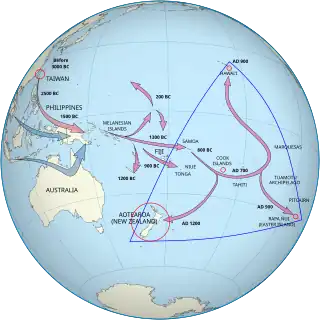
Starting about 3000 BCE, speakers of the Austronesian languages mastered the art of long-distance canoe travel and spread south to the Philippines, Malaysia and Indonesia, then east to the islands of Micronesia and Melanesia.
The exact origins of the group and their early migration routes are controversial among historians. It is generally accepted that Taiwan was involved, since both genetic and linguistic evidence show that the indigenous Taiwanese people are Austronesians. But was their original home East China's Liangzhu Culture? Or Southern China? Did they reach Malaya by sea or mainly by overland migration?
The maritime jade route had extensive trade between the Austronesian peoples of Southeast Asia from before 2000 BCE to after 500 CE.
The Polynesians branched off and occupied Polynesia to the east, taking with them their dogs, pigs, chickens and "canoe plants": taro, breadfruit, noni, bamboo, bananas, hibiscus, rice, ginger et cetera. They seem to have started from the Bismarck Archipelago, and gone east reaching Samoa and Tonga before 1000 BCE and Tahiti before 500 BCE. When they reached the Marquesas Islands, much further east, is controversial; estimates range from before 100 CE to after 1000. The more remote Easter Island and Hawaii were reached after 800. Far to the southwest, New Zealand was reached about 1250.
Another group went west instead and settled on the island of Madagascar off the eastern coast of Africa, probably about 500 CE.
- 🌍 Te Papa Museum, Wellington, New Zealand. It has an excellent exhibition on Polynesian exploration. (updated May 2020)
The Polynesians certainly had contact with the Americas by about 1100 CE, and perhaps earlier. There is DNA evidence, and the South American sweet potato (Ipomoea batatas) was a "canoe plant". Thor Heyerdahl sailed a raft called Kon-Tiki from Peru to Polynesia to demonstrate his hypothesis that Polynesia was populated mainly from the east, but that notion is not widely accepted.
- See also: Maori culture
Exploring the Mediterranean
Ancient Greece was a seafaring civilisation, trading with others in the eastern Mediteranean and with colonies on the Black Sea. The legends of the Trojan War give an account of seafaring on the Mediterranean Sea around the 12th century BC.
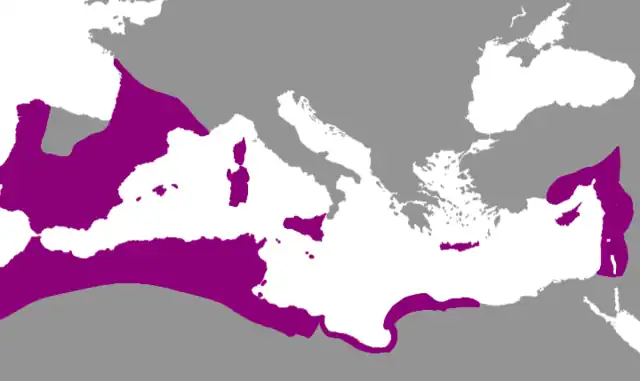
The Phoenicians were a maritime civilisation based in the Levant — areas that are now in Lebanon, Syria, Israel, Jordan and the Palestinian territories — roughly 2500-100BCE with their peak 1200-800BCE.
They developed sea routes around the entire Mediterranean with colonies or trading posts on islands such as Cyprus, Crete, Sicily and Sardinia and on the European mainland at Marseilles and Genoa. They also went into the Atlantic, reaching England by sailing along the western European coast, mainly to trade for tin.
According to Herodotus, an expedition sent by Egyptian Pharaoh Necho II and manned by Phoenicians found the Cape Route around 600 BCE.
In Phoenecia:
- 🌍 Byblos (35km north of Beirut). An ancient port city with a crusader castle, a
 UNESCO World Heritage Site. It is one of the world's oldest cities, continuously inhabited since at least 5000 BCE.
UNESCO World Heritage Site. It is one of the world's oldest cities, continuously inhabited since at least 5000 BCE. - 🌍 Sidon (south of Beirut). Another important Phoenician port, possibly the oldest. Mentioned by Homer, and in the Bible as Jezebel's home town. Today it is Lebanon's third largest city, and the main tourist attraction is a crusader castle.
- 🌍 Tyre (South Lebanon). This was originally a Phoenician city. In the 4th century BCE it was besieged and taken by Alexander the Great. Later it was an important city under the Romans. Today it is Lebanon's fourth largest city, and a
 UNESCO World Heritage Site. It is known for well-preserved Roman architecture, including the largest and best-preserved example of a Roman Hippodrome, and for fine beaches. (updated Oct 2015)
UNESCO World Heritage Site. It is known for well-preserved Roman architecture, including the largest and best-preserved example of a Roman Hippodrome, and for fine beaches. (updated Oct 2015) - 🌍 El Mina (Tripoli (Lebanon)). Once an important port, today the scenic old city district of Tripoli.
Further west:
- 🌍 Malta. This archipelago was a Phoenician colony.
- 🌍 Cádiz (Spain). Said to be the oldest city in western Europe, it was founded by Phoenician sailors about 3,000 years ago. The Museum of Cádiz has a collection of Phoenician artefacts. (updated May 2020)
- 🌍 Tripoli (Libya). Originally a Phoenician colony, today Libya's capital and largest city.
- 🌍 Carthage (near modern Tunis, Tunisia). Originally a Phoenician colony, this city became the capital of a small empire and fought several wars against the Roman Empire. The Romans destroyed it and later rebuilt it; most of today's remains are Roman, a
 UNESCO World Heritage Site.
UNESCO World Heritage Site.
See Ferries in the Mediterranean for ways to travel some of these routes today.
Exploring the North Atlantic
- Main article: Vikings and the Old Norse
The Vikings, a Norse people from southern Scandinavia, explored westwards to Iceland, Greenland, and Vinland (now Newfoundland) around 1000 CE.
- 🌍 L'Anse aux Meadows (near the northern tip of Newfoundland). The only confirmed Viking site in North America.
A few Viking artifacts have been found some distance south along the American coast and inland along the St. Lawrence and Great Lakes waterways. It is not clear whether these were brought by visiting Vikings or by trade among the indigenous tribes.
From the late 8th to late 11th centuries, the Vikings raided and traded across wide areas of Europe, founding 🌍 Kievan Rus and raiding as far as the Mediterranean.
The great medieval travellers
Quite a few medieval travellers went east, and some became quite well known because they each wrote a book about the lands they had visited.
Benjamin of Tudela was a Jewish traveller from what is now Spain who went as far East as Persia in the 12th century.
Marco Polo was a Venetian traveller who went far to the East, following some of the many branches of the Silk Road. He left in 1271 and returned about 1295. His book about his travels was a best-seller then and is still well-known 700 years later. He travelled extensively through Turkey, Central Asia, China, Southeast Asia, and the Indian subcontinent. There were – both in his time and in the modern era – doubts about the veracity of his accounts, but his descriptions of incredible riches in the east were among the motivating factors for later European conquerors and explorers.
Ibn Battuta was a Moroccan traveler who made the Hajj pilgrimage and went further east. He covered much of the same ground as Polo about half a century later and visited a number of other places as well.
Exploring the Indian Ocean
- Main article: Voyages of Zheng He
Zheng He was a Chinese mariner, explorer, diplomat, and fleet admiral during the early Ming dynasty. His fleets sailed the Maritime Silk Road to Southeast Asia, the Indian Subcontinent, Western Asia, and East Africa from 1405 to 1433. His larger ships carried hundreds of sailors on four decks and were almost twice as long as any other wooden ship ever recorded.
The Arabian Nights tales included the voyages of Sinbad the Sailor around the Indian Ocean.
The Age of Discovery
- Main article: Age of Discovery
The period from the 15th century to the late 18th, when Europeans set sail to discover and explore other lands, also marked the beginning of European colonialism and mercantilism, as well as the beginning of globalization. It is commonly known as the Age of Discovery, or the Age of Exploration. The Age of Discovery is generally considered to end with the late 18th-century explorations of the Pacific by Tasman, Cook, Vancouver and Flinders.
While the European explorers did discover many uninhabited islands, for the most part they were exploring lands that had been discovered and settled by other people thousands of years before. The widely-used term "Age of Discovery" reflects the Eurocentric view of the world that existed at the time.
Today The Ocean Race is a prestigious event; participants circumnavigate the globe in a sailboat, eastwards around both the Cape of Good Hope and Cape Horn.
Later explorers
Fabian von Bellingshausen
Bellingshausen (1778-1852) was a Russian naval officer, cartographer and explorer of Baltic German extraction, who participated in the First Russian circumnavigation of the globe (1803–1806). A great admirer of Cook's voyages, Bellingshausen was one of the officers of the vessel Nadezhda ("Hope"), commanded by Adam Johann von Krusenstern.
Bellingshausen was appointed to command the second Russian circumnavigation of the globe (1819–1821), intended to explore the Southern Ocean and to find land in the proximity of the South Pole. Mikhail Lazarev prepared the expedition and was made Bellingshausen's second-in-command and the captain of the sloop Mirny, while Bellingshausen himself commanded the sloop Vostok. During this expedition Bellingshausen and Lazarev became the first explorers to see the land of Antarctica, on 27 January 1820. They circumnavigated the continent twice and never lost each other from view. Thus they disproved Captain Cook's assertion that it was impossible to find land in the southern icefields.
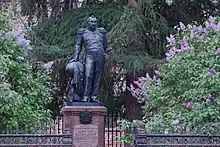
Returning to Kronstadt, the naval base at the approaches of St Petersburg, on 4 August 1821, Bellingshausen was made counter admiral. He fought in the Russo-Turkish War of 1828–1829 and attained the rank of vice admiral in 1830. In 1831 he published his book on his Antarctic travel, and in 1839 became the military governor of Kronstadt, where he died in January 1852, and was buried with full military honors.
- 🌍 Kunstkamera, St. Petersburg, Russia. It houses collections of artifacts from Russian circumnavigations of the world, including Bellingshausen's. (updated May 2020)
- 🌍 Statue of Bellingshausen, Sovetskaya ulitsa, Ekaterinskii Park, Kronstadt. (updated May 2020)
- 🌍 Kronstadt Lutheran Cemetery. Bellingshausen's tomb has a statue of him in dress uniform, erected in 1870, and is the highlight of this place. (updated May 2020)
Overland explorers
Chinese expansion
The Chinese civilization started around the Yellow River basin, and its first historically confirmed dynasty, the Shang Dynasty (c. 1700-1027 BCE) ruled only that area. It would then expand southward into the Yangtze River basin during the Zhou Dynasty (c. 1027-256 BCE), before expanding further southward into what is today Fujian and Guangdong, as well as parts of what is today Northern Vietnam during the Qin (221-206 BCE) and Han (206 BCE-220 CE) dynasties. The Han Dynasty also expanded westward into what is today Xinjiang, ushering in the beginning of the Silk Road. Although the Chinese would lose control of Xinjiang after the fall of the Han Dynasty, it would return to Chinese control during the Tang Dynasty (618-907); this led to the revival and expansion of the Silk Road.
During the Tang Dynasty the Chinese Buddhist monk Xuanzang made a pilgrimage to India to collect Buddhist scriptures. This journey was greatly romanticised in the Ming Dynasty novel Journey to the West, with numerous mythological elements thrown in. In modern times, the novel has been adapted into popular television shows. Most of the sites Xuanzang visited on his journey are in modern-day India, Pakistan and Afghanistan, including Bamiyan and the Buddhist learning centres of Taxila and Nalanda. After returning to China, Xuanzang dedicated the rest of his life to translating the Buddhist scriptures he had brought back with him from Sanskrit to Chinese.
Today, cities along the Silk Road are major tourist sites in China, including the Longmen Grottoes. The city of Kashgar in Xinjiang was also along the old Silk Road; today, it is an Uyghur-majority city with a distinctly Central Asian character, known for its production of Uyghur carpets, and a major centre of Uyghur culture.
- See also: Imperial China, Silk Road
North American fur traders
The first Europeans to explore much of western Canada and the western US were the voyageurs, French-speaking fur traders working out of Montreal starting in the 16th century.
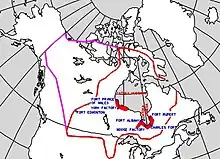
Their original charter gave them all the land whose rivers drained into the bay.
Later, it was extended west.
By the 17th century they had English-speaking competitors, mainly Scots working for the Hudson's Bay Company (HBC). There were also Dutch, English and later American traders, mostly working out of New York and Boston, and later other traders working from the Pacific coast.
There are traces of this exploration in place names all over the continent; see voyageurs for some of the French ones. Several Canadian rivers, such as the Mackenzie, the Fraser and the Thompson, are named for HBC explorers and some modern towns such as Edmonton developed from HBC trading posts.
In 1870 the HBC's territory, known as Rupert's Land, was turned over to the British Crown and then to the Canadian government. Parts of it became the three prairie provinces — Manitoba, Saskatchewan and Alberta, while other parts were added to Ontario and Quebec. The parts north of 60 degrees latitude, plus some other land, became what are now the Yukon, Northwest Territories and Nunavut. The southernmost parts went to the US when the border disputes were settled.
.jpg.webp)
The company's main base, in effect the capital of Rupert's Land, was York Factory on Hudson's Bay. It has long since been abandoned and has no road, rail or air connections. It can be visited by helicopter from Churchill.
Today the Hudson's Bay Company is a major department store chain in Canada and has some stores in the US. Items that recall the fur trade days, like parkas or their brightly-striped blankets, are popular with foreign visitors as distinctly Canadian souvenirs.
Henry Hudson (1565-1611?) was an Englishman who led several expeditions under the British flag seeking the Northwest Passage. He also explored areas further south for the Dutch East India Company, leading to that company founding "New Amsterdam" which later became New York City. Both Hudson's Bay and the Hudson River are named after him.
American westward expansion
- Main article: Old West
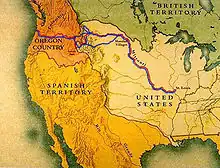
Once the various colonial powers established bases on the east coasts of the two American continents, they all sent out explorers who went further west. Wikivoyage covers some of this in an article on the North American Old West.
- 🌍 Lewis and Clark. This expedition explored much of the American West, following the Missouri River before traveling across the Rocky Mountains to the Columbia River and ultimately 🌍 Fort Clatsop where the Columbia reaches the Pacific Ocean.
Their journey (1804-1806) marked the beginning of the pioneer era of American exploration and settlement in the Indigenous lands of the western U.S., but is also known for its in-depth study and drawings of the plant and animal life of the region that the expedition explored. - Oregon Trail. This was a major route for settlers of the American Northwest.
- 🌍 Santa Fe Trail. This was a major route for settlers of the American Southwest.
Russian expansion
- Main article: Russian Empire
The Grand Duchy of Moscow, which later became the Tsardom of Russia, became independent of the Golden Horde (a remnant of the Mongol Empire) in 1480 and began expanding, at first mainly by annexing neighbouring states. Then, starting in the late 1500s, they explored Siberia and colonized much of it.
Starting about 1785 they also expanded into the Caucasus and Central Asia; in the 18th and 19th centuries they fought wars against the Persian and Ottoman Empires, the latter over Crimea. The Great Game was an intense 19th century geopolitical competition between the Russian Empire and the British Empire for influence in Central Asia and Afghanistan.
The area around Vladivostok was ceded to Russia by China's Qing Dynasty in 1858, and Vladivostok became the first Russian naval base on the Pacific; today it is still a major naval base, but also the most important city of its region and a tourist destination. Russia also had large influence in Manchuria, and a naval base at Port Arthur (now Dalian), until their defeat in the 1905 Russo-Japanese War.
Russia also did some maritime exploration and from the 1740s to 1867 had an overseas colony in Alaska.
Exploration of inland Asia
- Main article: Voyages of Sven Hedin
Polar explorers
The polar regions were explored mainly in the 19th and early 20th centuries.
In the North, a major objective was to find the Northwest Passage, a sea route from Europe to the Orient that would be shorter than then-known routes. The search began with John Davis in the 1580s but no-one made it all the way through until Amundsen in 1906.
The southern voyages of Scott, Shackleton and Amundsen are often called the "Heroic Age of Antarctic Exploration".
Sir John Franklin

- Main article: Voyages of John Franklin
Franklin (1786-1847) was a British Royal Navy officer and explorer of Arctic North America. He led three expeditions between 1819 and 1845, disappearing on his last, an attempt to chart and navigate the Northwest Passage on Erebus and Terror. A long search for him, prompted by his wife and the Admiralty's offer of a finder's reward, led to the precise mapping of North American waters. The wrecks were located in the 2010s.
Robert Edwin Peary
Peary was a United States Navy officer who made several expeditions to the Arctic in the late 19th and early 20th centuries. He is best known for claiming to have reached the geographic North Pole with his expedition in 1909.
- 🌍 The Peary–MacMillan Arctic Museum, Brunswick, Maine, USA. Artifacts include Peary's expedition equipment, anthropological objects, Inuit art, films, archival papers, publications, and natural history specimens. (updated May 2020)
- 🌍 Fort Conger, Lady Franklin Bay (about 100 km south of Alert, Nunavut). In the period 1880–1884, the US Army Signal Corps chose this site for a base camp to make an attempt to reach the North Pole. A party of 25 military men, led by First Lieutenant Adolphus W. Greely as acting signal officer, was successfully landed by the USS Proteus in August 1881. A large frame structure was built on the northwest shore. This home base camp, named Fort Conger, was later occupied by Robert Peary during some of his Arctic expeditions. In 1991, some of the structures at Fort Conger were designated by the Canadian government as Classified Federal Heritage Buildings. (updated May 2020)
Robert Falcon Scott
Scott was a British Royal Navy officer who led two expeditions to the Antarctic regions in 1901–1904 and 1910–1913. On the first expedition, he set a new southern record by marching to latitude 82°S and discovered the Antarctic Plateau, on which the South Pole is located.
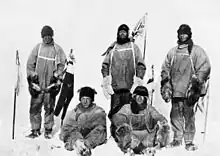
On the second venture, Scott followed a better route which Shackleton had discovered and — unlike Shackleton who turned back when he thought continuing would be too risky — made it all the way to the pole. Scott led a party of five, which reached the South Pole less than five weeks after Amundsen's South Pole expedition; they all died on the return trip.
- 🌍 Scott Polar Research Institute Museum, Cambridge, UK. The exhibition on the Heroic Age of Antarctic Exploration includes the last letters of Scott, and a folding camera used by Scott at the South Pole. (updated May 2020)
- 🌍 National Maritime Museum, Greenwich, London, UK. Its collections hold objects from Scott's final and tragic Antarctic expedition, including his overshoes, sledging goggles, book bag, and the theodolite he used navigating through unfamiliar Antarctic landscapes. (updated May 2020)
Sir Ernest Henry Shackleton
-en.svg.png.webp)
Shackleton was an Irishman, second-in-command to Scott in 1901-1904. He went on to lead three British expeditions of his own to the Antarctic (Nimrod expedition 1907–1909, Imperial Trans-Antarctic Expedition 1914–1917, Shackleton–Rowett Expedition 1921). Although he did not reach the pole he discovered the route Scott later used to do so, and he never lost a man under his command.
In 1921, he died of a heart attack while his ship was still moored in South Georgia; at his wife's request, he was buried there.
- 🌍 Norwegian Anglican Church (Whalers Church), Grytviken, South Georgia. Site of Ernest Shackleton's grave. (updated Jan 2020)
Roald Amundsen
- Main article: Voyages of Roald Amundsen
Amundsen was a Norwegian explorer of polar regions. He led the first expedition to traverse the Northwest Passage by sea, from 1903 to 1906. He also led the first expedition to reach the South Pole in 1911. Amundsen led the first expedition proven to have reached the North Pole in a dirigible in 1926, and disappeared while taking part in a rescue mission for the airship Italia in 1928.
Mountain explorers
Mountaineering on well-travelled routes is mainly a recreation, but some mountaineers go to places no-one has been before and can be counted as explorers.
The Explorers Grand Slam is said to have been completed when someone completes expeditions to both poles, and successfully scales the Seven Summits, the highest mountains on each continent.
Edmund Hillary and Tenzing Norgay
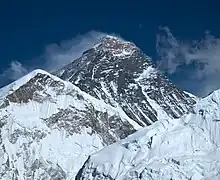
- Main article: Mount Everest
Edmund Hillary and Tenzing Norgay were New Zealander and Nepali Sherpa mountaineers respectively, and became the first humans to reach the summit of Mount Everest, the highest point in the world, on the Himalayan border between Nepal and China, in 1953. Today, the Everest Base Camp Trek is quite popular with visitors to Nepal; it gives superb views of the mountain and is reasonably safe though perhaps too strenuous for some.
Actually climbing Everest is considerably more difficult and dangerous, not to be considered except by expert mountaineers with good guides and equipment. The terrain, weather and altitude sickness kill climbers rather often; there are about 200 corpses on the mountain.
Mountaineers can climb Mount Everest from either the Nepali or Chinese side, though permits are required in either case. As the Chinese face of the mountain (to the north, considered harder by climbers) is actually in Tibet, you will need to arrange for a Tibet Entry Permit just to get near it. Norgay and Hillary ascended the Nepali face (to the south, easier), regarded as safer, as do the vast majority of mountaineers, but there are also unique views to be had on the Chinese side.
Achille Compagnoni and Lino Lacedelli
Italian mountaineers Achille Compagnoni and Lino Lacedelli were the first humans to successfully reach the summit of K2, the world's second highest peak. Located at the border between Pakistan's Gilgit-Baltistan region and China's Xinjiang region, it is considered a more difficult and dangerous climb than Everest, partly because it is further north so nasty weather is more common. It is attempted much less often than Everest, but almost a hundred people have died trying the climb. The vast majority of mountaineers attempt the ascent from the Pakistani side, as the Chinese side is regarded as more challenging and hazardous.
The K2 base camp trek is possible.
Stay safe
All the explorers mentioned were brave men and the journeys they undertook were quite dangerous at the time. One historian has claimed that making Magellan's round-the-world trip with 16th-century technology was riskier than going to the moon with 20th-century technology.
Some of these are far safer today. For example, the battlefield where Magellan was killed is now within a few km of both a major airport and several luxury hotels; people routinely follow the Lewis and Clark Trail by car; and cruise ships now run along parts of Cook and Vancouver's routes along the Canadian and Alaskan coast.
Others remain extremely dangerous; some are nearly suicidal if attempted without adequate planning, skills and equipment, and risky even with those. Examples include climbing Everest or K2, travelling in Antarctica, and sailing south of South America — via either the Straits of Magellan or the Drake Passage — even in a modern boat.